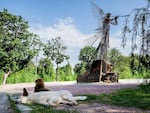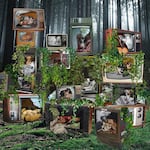
"Mia, lounging in front of the trumpeting angel memorial", a film still from Julia Oldham's documentary, "Fallout Dogs", shot in the Chernobyl exclusion zone.
Courtesy of Julia Oldham.
Artist Julia Oldham is about to open
based on her visit to one of the most haunting urban landscapes in the world.
In May, she spent several days in the Ukranian city of Pripyat, home of the Chernobyl Nuclear Power Plant. In 1986, an explosion at the plant created the worst nuclear plant disaster in history. Thirty-one people died in the immediate aftermath. Pripyat — a city roughly the size of Pendleton — was evacuated and ultimately abandoned.
The bulk of her photography was dedicated to a long-term project: a documentary film about the dogs of Chernobyl. The clip she posted promises a lovely and spooky treatment.
But still photography from the trip has yielded a fascinating side project.
"The exclusion zone has grown over with wild, beautiful forests and animals have moved into the area," Oldham said. Wolves and moose and wild boars rule the forests.
Oldham said walking through the deserted streets of the city, its Soviet modernist apartments and hospital crumbling and increasingly edged out by nature, was a profoundly strange experience.
"It was designed as this atomic city," she said. "It's one thing to see an abandoned little village that's become overgrown, but you're seeing an entire abandoned city, with high rises. It looks very post-apocalyptic."

In addition to gathering documentary footage at Chernobyl, Julia Oldham gathered photos for constructed collages, inspired by dogs in the exclusion zone. “I thought it was an interesting way of approaching really scary issues, to create an idealized post-human world full of dogs.”
Courtesy of Julia Oldham
Her mission was to photograph the domestic animals left behind after Chernobyl. Oldham's work has always been closely tied to the natural world, and especially dogs.
The population of stray dogs (and cats, who appeared to be living relatively peacefully with the dog population, Oldham said) living in the exclusion zone has not gone feral but survive with the help of the few remaining humans who live and work in the Chernobyl exclusion zone. One of those humans was Oldham's guide, Ludmilla Juraschko.
Amid her process of collecting video, Oldham had enough stills from the startling streets of Pripyat that she decided to print up some images. Inspired by her research about Chernobyl, Oldham gathered pictures of dogs — her own pets, dogs she met in the exclusion zone and friends' pets. She used them to assemble collages of constructed landscapes with a variety of found images — everything from landfills to idyllic mountains to piles of CRT monitors.
"I made these landscapes as a way of imagining a fantastical post-human-civilization future," Oldham said, "where there are just traces of us left, and animals have taken over."
The spectacularly large prints, enhanced with some digital drawing, make up Oldham's part of the exhibition "Dogs of Future Earth."
See it at Olympic Mills Commerce Center in Portland, Sept. 1 through Nov. 21, alongside work by artist and curator Angelee van Allman.
